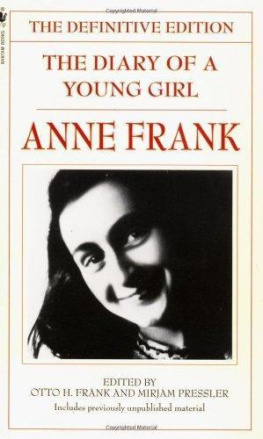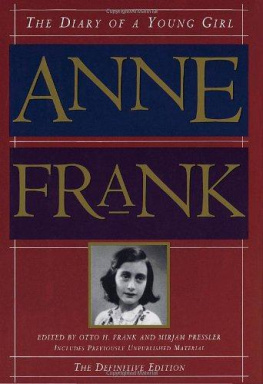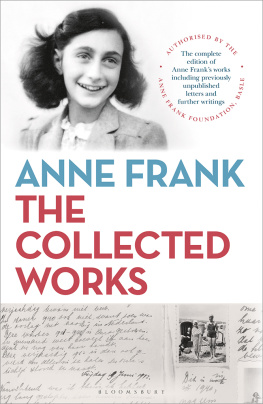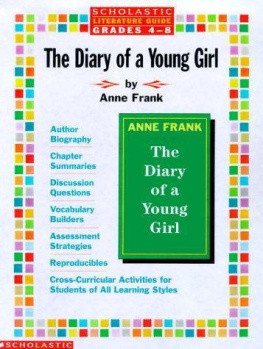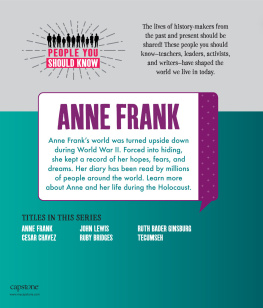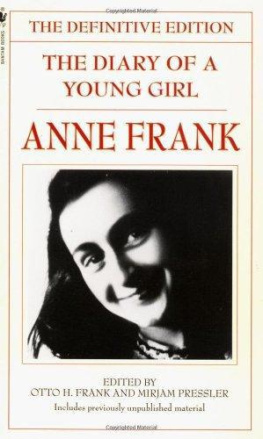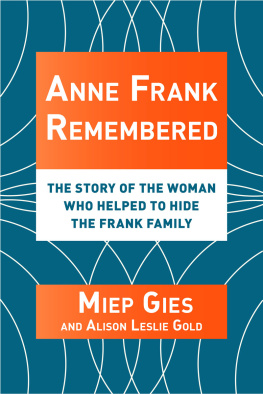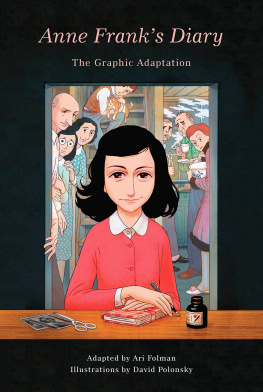Anne Frank - The Diary of a Young Girl: Anne Frank
Here you can read online Anne Frank - The Diary of a Young Girl: Anne Frank full text of the book (entire story) in english for free. Download pdf and epub, get meaning, cover and reviews about this ebook. year: 0, genre: Non-fiction / History. Description of the work, (preface) as well as reviews are available. Best literature library LitArk.com created for fans of good reading and offers a wide selection of genres:
Romance novel
Science fiction
Adventure
Detective
Science
History
Home and family
Prose
Art
Politics
Computer
Non-fiction
Religion
Business
Children
Humor
Choose a favorite category and find really read worthwhile books. Enjoy immersion in the world of imagination, feel the emotions of the characters or learn something new for yourself, make an fascinating discovery.
- Book:The Diary of a Young Girl: Anne Frank
- Author:
- Genre:
- Year:0
- Rating:5 / 5
- Favourites:Add to favourites
- Your mark:
- 100
- 1
- 2
- 3
- 4
- 5
The Diary of a Young Girl: Anne Frank: summary, description and annotation
We offer to read an annotation, description, summary or preface (depends on what the author of the book "The Diary of a Young Girl: Anne Frank" wrote himself). If you haven't found the necessary information about the book — write in the comments, we will try to find it.
The Diary of a Young Girl: Anne Frank — read online for free the complete book (whole text) full work
Below is the text of the book, divided by pages. System saving the place of the last page read, allows you to conveniently read the book "The Diary of a Young Girl: Anne Frank" online for free, without having to search again every time where you left off. Put a bookmark, and you can go to the page where you finished reading at any time.
Font size:
Interval:
Bookmark:
THE DIARY OF
A YOUNG GIRL :
THE
DEFINITIVE EDITION
Anne Frank
Edited by Otto H. Frank and Mirjam Pressler
Translated by Susan Massotty
TABLE OF CONTENTS
FOREWORD
Anne Frank kept a diary from June 12, 1942, to August 1, 1944. Initially, she wrote it strictly for herself. Then, one day in 1944, Gerrit Bolkestein, a member of the Dutch government in exile, announced in a radio broadcast from London that after the war he hoped to collect eyewitness accounts of the suffering of the Dutch people under the German occupation, which could be made available to the public. As an example, he specifically mentioned letters and diaries.
Impressed by this speech, Anne Frank decided that when the war was over she would publish a book based on her diary. She began rewriting and editing her diary, improving on the text, omitting passages she didnt think were interesting enough and adding others from memory. At the same time, she kept up her original diary. In the scholarly work The Diary of Anne Frank: The Critical Edition (1989), Annes first, unedited diary is referred to as version a, to distinguish it from her second, edited diary, which is known as version b.
The last entry in Annes diary is dated August 1, 1944. On August 4, 1944, the eight people hiding in the Secret Annex were arrested. Miep Gies and Bep Voskuijl, the two secretaries working in the building, found Annes diaries strewn allover the floor. ,Miep Gies tucked them away in a desk drawer for safekeeping. After the war, when it became clear that Anne was dead, she gave the diaries, unread, to Annes father, Otto Frank.
After long deliberation, Otto Frank decided to fulfill his daughters wish and publish her diary. He selected material from versions a and b, editing them into a shorter version later referred to as version c. Readers all over the world know this as The Diary of a fauna Girl.
In making his choice, Otto Frank had to bear several points in mind. To begin with, the book had to be kept short so that it would fit in with a series put out by the Dutch publisher. In addition, several passages dealing with Annes sexuality were omitted; at the time of the diarys initial publication, in 1947, it was not customary to write openly about sex, and certainly not in books for young adults. Out of respect for the dead, Otto Frank also omitted a number of unflattering passages about his wife and the other residents of the Secret Annex. Anne Frank, who was thirteen when she began her diary and fifteen when she was forced to stop, wrote without reserve about her likes and dislikes.
When Otto Frank died in 1980, he willed his daughters manuscripts to the Netherlands State Institute for War Documentation in Amsterdam. Because the authenticity of the diary had been challenged ever since its publication, the Institute for War Documentation ordered a thorough investigation. Once the diary was proved, beyond a shadow of a doubt, to be genuine, it was published in its entirety, along with the results of an exhaustive study. The Critical Edition contains not only versions a, band c, but also articles on the background of the Frank family, the circumstances surrounding their arrest and deportation, and the examination into Annes handwriting, the document and the materials used.
The Anne Frank-Fonds (Anne Frank Foundation) in Basel (Switzerland),. which as Otto Franks sole heir had also inherited his daughters copyrights, then decided to have anew, expanded edition of the diary published for general readers. This new edition in no way affects the integrity of the old one originally edited by Otto Frank, which brought the diary and its message to millions of people. The task of compthng the expanded edition was given to the writer and translator Mirjam Pressler. Otto Franks original selection has now been supplemented with passages from Annes a and b versions. Mirjam Presslers definitive edition, approved by the Anne Frank-Fonds, contains approximately 30 percent more material and is intended to give the reader more insight into the world of Anne Frank.
In writing her second version (b), Anne invented pseudonyms for the people who would appear in her book. She initially wanted to call herself Anne Aulis, and later Anne Robin. Otto Frank opted to call his family by their own names and to follow Annes wishes with regard to the others. Over the years, the identity of the people who helped the family in the Secret Annex has become common knowledge. In this edition, the helpers are now referred to by their real names, as they so justly deserve to be. All other persons are named in accordance with the pseudonyms in The Critical Edition. The Institute for War Documentation has arbitrarily assigned initials to those persons wishing to remain anonymous.
The real names of the other people hiding in the Secret Annex are:
THE VAN PELS FAMILY
(from Osnabriick, Germany):
Auguste van Pels (born September 9, 1890)
Hermann van Pels (born March 31, 1889)
Peter van Pels (born November 8, 1926)
Called by Anne, in her manuscript: Petronella, Hans and Alfred van Daan; and in the book: Petronella, Hermann and Peter van Daan.
FRITZ PFEFFER
(born April 30, 1889, in Giessen, Germany):
Called by Anne, in her manuscript and in the book: Alfred Dussel.
The reader may wish to bear in mind that much of this edition is based on the b version of Annes diary, which she wrote when she was around fifteen years old. Occasionally, Anne went back and commented on a passage she had written earlier. These comments are clearly marked in this edition. Naturally, Annes spelling and linguistic errors have been corrected. Otherwise, the text has basically been left as she wrote it, since any attempts at editing and clarification would be inappropriate in a historical document.
June 12, 1942
I hope I will be able to confide everything to you, as I have never been able to confide in anyone, and I hope you will be a great source of comfort and support.
COMMENT ADDED BY ANNE ON SEPTEMBER 28, 1942: So far you truly have been a great source of comfort to me, and so has Kitty, whom I now write to regularly. This way of keeping a diary is much nicer, and now I can hardly wait for those moments when Im able to write in you. Oh, Im so glad I brought you along!
SUNDAY, JUNE 14, 1942
Ill begin from the moment I got you, the moment I saw you lying on the table among my other birthday presents. (I went along when you were bought, but that doesnt count.)
On Friday, June 12, I was awake at six oclock, which isnt surprising, since it was my birthday. But Im not allowed to get up at that hour, so I had to control my curiosity until quarter to seven. When I couldnt wait any longer, I went to the dining room, where Moortje (the cat) welcomed me by rubbing against my legs.
A little after seven I went to Daddy and Mama and then to the living room to open my presents, and you were the first thing I saw, maybe one of my nicest presents. Then a bouquet of roses, some peonies and a potted plant. From Daddy and Mama I got a blue blouse, a game, a bottle of grape juice, which to my mind tastes a bit like wine (after all, wine is made from grapes), a puzzle, a jar of cold cream, 2.50 guilders and a gift certificate for two books. I got another book as well, Camera Obscura (but Margot already has it, so I exchanged mine for something else), a platter of homemade cookies (which I made myself, of course, since Ive become quite an expert at baking cookies), lots of candy and a strawberry tart from Mother. And a letter from Grammy, right on time, but of course that was just a coincidence.
Then Hanneli came to pick me up, and we went to school. During recess I passed out cookies to my teachers and my class, and then it was time to get back to work. I didnt arrive home until five, since I went to gym with the rest of the class. (Im not allowed to take part because my shoulders and hips tend to get dislocated.) As it was my birthday, I got to decide which game my classmates would play, and I chose volleyball. Afterward they all danced around me in a circle and sang Happy Birthday. When I got home, Sanne Ledermann was already there. Ilse Wagner, Hanneli Goslar and Jacqueline van Maarsen came home with me after gym, since were in the same class. Hanneli and Sanne used to be my two best friends. People who saw us together used to say, There goes Anne, Hanne and Sanne. I only met Jacqueline van Maarsen when I started at the Jewish Lyceum, and now shes my best friend. Ilse is Hannelis best friend, and Sanne goes to another school and has friends there.
Font size:
Interval:
Bookmark:
Similar books «The Diary of a Young Girl: Anne Frank»
Look at similar books to The Diary of a Young Girl: Anne Frank. We have selected literature similar in name and meaning in the hope of providing readers with more options to find new, interesting, not yet read works.
Discussion, reviews of the book The Diary of a Young Girl: Anne Frank and just readers' own opinions. Leave your comments, write what you think about the work, its meaning or the main characters. Specify what exactly you liked and what you didn't like, and why you think so.

